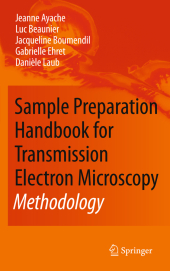 Neuerscheinungen 2014Stand: 2020-02-01 |
Schnellsuche
ISBN/Stichwort/Autor
|
Herderstraße 10
10625 Berlin
Tel.: 030 315 714 16
Fax 030 315 714 14
info@buchspektrum.de |

Jeanne Ayache, Luc Beaunier, Jacqueline Boumendil
(Beteiligte)
Sample Preparation Handbook for Transmission Electron Microscopy
Methodology
2010. 2014. xxiii, 250 S. 20 Tabellen. 235 mm
Verlag/Jahr: SPRINGER, BERLIN; SPRINGER NEW YORK; SPRINGER 2014
ISBN: 1-489-98697-9 (1489986979)
Neue ISBN: 978-1-489-98697-9 (9781489986979)
Preis und Lieferzeit: Bitte klicken
This guide is divided into two sections. The first covers theoretical and practical aspects, including the best preparative technique. The second part offers technical hints, including twenty-two detailed protocols for preparing thin slices for TEM analysis.
Successful transmission electron microscopy in all of its manifestations depends on the quality of the specimens examined. Biological specimen preparation protocols have usually been more rigorous and time consuming than those in the physical sciences. For this reason, there has been a wealth of scienti?c literature detailing speci?c preparation steps and numerous excellent books on the preparation of b- logical thin specimens. This does not mean to imply that physical science specimen preparation is trivial. For the most part, most physical science thin specimen pre- ration protocols can be executed in a matter of a few hours using straightforward steps. Over the years, there has been a steady stream of papers written on various aspects of preparing thin specimens from bulk materials. However, aside from s- eral seminal textbooks and a series of book compilations produced by the Material Research Society in the 1990s, no recent comprehensive books on thin spe- men preparation have appeared until this present work, ?rst in French and now in English. Everyone knows that the data needed to solve a problem quickly are more imp- tant than ever. A modern TEM laboratory with supporting SEMs, light microscopes, analytical spectrometers, computers, and specimen preparation equipment is an investment of several million US dollars. Fifty years ago, electropolishing, chemical polishing, and replication methods were the principal specimen preparation me- ods.
Methodology: General Introduction.- to Materials.- The Different Observation Modes in Electron Microscopy (SEM, TEM, STEM).- Materials Problems and Approaches for TEM and TEM/STEM Analyses.- Physical and Chemical Mechanisms of Preparation Techniques.- Artifacts in Transmission Electron Microscopy.- Selection of Preparation Techniques Based on Material Problems and TEM Analyses.- Comparisons of Techniques.- Conclusion: What Is a Good Sample?.


